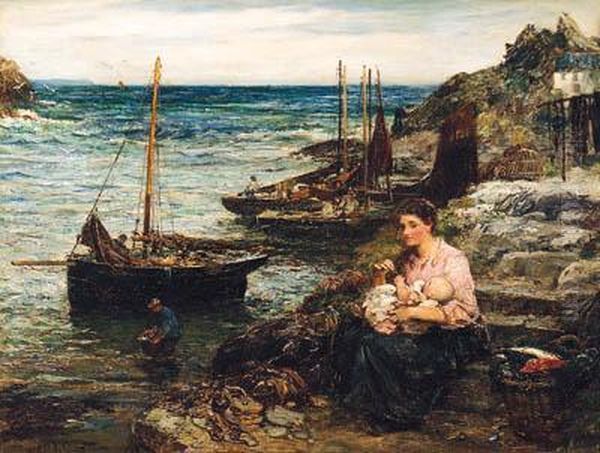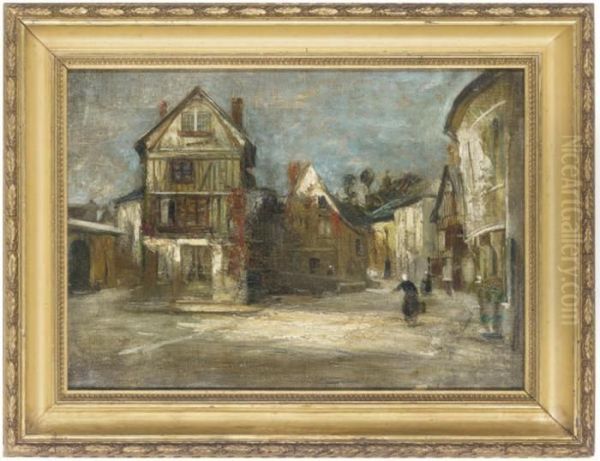John Robertson Reid stands as a significant figure in late nineteenth and early twentieth-century British art. Born in Edinburgh, Scotland, in 1851, and passing away in London in 1926, Reid carved a distinct niche for himself as a painter dedicated to capturing the realities of rural and coastal life. He was educated at the prestigious Royal Scottish Academy, laying the foundation for a career that would see him become a leading proponent of Naturalism in Britain, known particularly for his evocative landscapes, scenes of agricultural labour, and depictions of fishing communities in Surrey and Cornwall. His work bridged the gap between Victorian narrative painting and a more modern, objective approach influenced by continental trends.
Early Life and Artistic Formation
John Robertson Reid's artistic journey began in the culturally rich environment of Edinburgh. His formal training at the Royal Scottish Academy provided him with the technical skills necessary for his future career. The Academy, a crucible for Scottish artistic talent, would have exposed him to the prevailing trends of the time, likely including the detailed landscape tradition and the narrative inclinations of Victorian art. While specific details of his earliest influences within the Academy are not extensively documented, the rigorous training undoubtedly honed his observational skills and draughtsmanship, qualities evident throughout his mature work. His Scottish roots perhaps instilled in him an appreciation for landscape and the hardy character of working people, themes he would return to repeatedly.
A Move South: Surrey and Cornwall
Seeking broader horizons and new subject matter, Reid moved south to England. Initially, he spent time working in Surrey, a county whose gentle landscapes and rural life offered ample inspiration. However, a pivotal shift occurred in the early 1880s when Reid relocated to Cornwall. This move placed him in the heart of a region that was rapidly becoming a magnet for artists drawn to its dramatic coastline, unique quality of light, and the traditional lives of its fishing communities.

Though not strictly based in the famous art colony of Newlyn, Reid's time in Cornwall coincided with the rise of the Newlyn School. Artists like Stanhope Forbes, Frank Bramley, and Walter Langley were working nearby, similarly dedicated to capturing the local fisherfolk and rural scenes with a newfound realism and often employing plein-air techniques. Reid shared their commitment to depicting everyday life with honesty and empathy, contributing significantly to the broader movement of British coastal painting during this period. The rugged Cornish environment provided him with powerful subjects, from bustling harbours to quiet moments of contemplation by the sea.
Embracing Naturalism: Style and Influences
John Robertson Reid became a key exponent of Naturalism in British art. This movement, distinct from Impressionism's focus on fleeting light effects, emphasized objective, detailed observation and the truthful depiction of rural life and landscapes, often painted outdoors (en plein air) to capture authentic conditions. Reid's work shows a clear affinity with this approach. His style is characterized by solid drawing, careful attention to detail, and a commitment to representing the textures and atmosphere of the scenes before him.
A significant influence on Reid, as with many British Naturalists, was the French painter Jules Bastien-Lepage. Bastien-Lepage's work, known for its high viewpoint, detailed foregrounds, tonal harmony, and unsentimental portrayal of peasant life, resonated deeply with artists seeking an alternative to academic convention. Reid adopted aspects of this style, including sometimes using the characteristic 'square brush' technique associated with Bastien-Lepage and his followers, which involved applying paint in distinct, blocky strokes to build form and texture. While aware of Impressionism, Reid's focus remained on the tangible reality and social dimension of his subjects rather than purely optical effects.
Chronicling Rural and Coastal Life
Reid's oeuvre is dominated by scenes of labour and leisure in the countryside and along the coast. He depicted farmhands toiling in the fields, fishermen mending nets or returning with their catch, and villagers engaged in everyday activities. His paintings often convey a sense of the dignity of labour and the quiet resilience of working people. He avoided overt sentimentality, instead presenting his subjects with a directness and honesty that was central to the Naturalist ethos. Works like The Cabbage Patch, dating from the 1880s, exemplify his interest in humble, domestic rural scenes, rendered with careful observation and a subdued palette. His coastal paintings captured the specific light and atmosphere of the English shoreline, populated by the figures who made their living from the sea.
Landmark Achievement: Toil and Pleasure

A defining moment in Reid's career came in 1879 with the exhibition of his painting Toil and Pleasure at the Royal Academy in London. The work was highly acclaimed and, significantly, was purchased for the nation through the Chantrey Bequest. The Chantrey Bequest was a fund established to acquire works of art of the "highest merit" for the national collection (now part of Tate Britain). The acquisition of Toil and Pleasure was a major endorsement of Reid's talent and his artistic direction. The painting, likely contrasting scenes of hard work with moments of simple enjoyment, resonated with contemporary interest in social themes and realistic depiction. This success cemented Reid's reputation and placed him firmly among the notable painters of his generation, aligning him with other artists exploring social realism, such as Hubert von Herkomer and Luke Fildes, albeit often with a less overtly critical edge.
Other Notable Works
Beyond Toil and Pleasure and The Cabbage Patch, Reid produced a substantial body of work that further explored his favoured themes. Paintings such as A Country Cricket Match captured the communal spirit and leisure activities of village life, rendered with his characteristic attention to detail and atmosphere. Works like The Poor are the Friends of the Poor hinted at a social conscience, depicting acts of mutual support among the less fortunate, a theme handled with empathy rather than melodrama. Rival Grandfathers likely explored gentle human interactions and character study within a rural setting. Across these works, Reid demonstrated his skill in composition, his ability to handle complex figure groups, and his consistent dedication to representing the specific character of the English landscape and its inhabitants.
Leadership Roles in the Art World
Reid's standing in the London art world was further confirmed by his election to prominent positions within major art societies. In 1886, he became President of the Society of British Artists (SBA). This was a significant role, and his tenure followed that of James McNeill Whistler, suggesting perhaps a shift in the society's direction or at least a recognition of Reid's prominence in a different vein of contemporary art. His leadership would have involved guiding the society's exhibitions and promoting its members.
Later, in 1898, Reid was elected President of the Society of Sculptors, Painters and Gravers (which evolved into the Royal Society of Painter-Printmakers). Holding the presidencies of two such organisations underscored his reputation among his peers and his active participation in the institutional structures of the British art scene. These roles provided him with platforms to influence artistic discourse and support fellow artists.
Exhibitions and Recognition

Throughout his career, John Robertson Reid was a regular exhibitor at the major London and Scottish venues. His work was frequently seen at the Royal Academy, the Royal Scottish Academy, the Royal Institute of Oil Painters, the Grosvenor Gallery, and other important exhibition spaces. Consistent participation in these prestigious shows ensured his visibility and allowed his work to be seen alongside that of the leading artists of the day. While the provided information regarding specific international exhibitions like Copenhagen needs careful verification, his status suggests his work would likely have been included in British sections of international expositions, reflecting the growing interest in British Naturalism abroad.
Artistic Connections and Influence
John Robertson Reid did not work in isolation. His sister, Flora MacDonald Reid (1861-1938), was also a successful painter, known for her lively street scenes and market squares, often featuring continental European settings. Having trained under her brother, her work shares some of the same commitment to observational detail and capturing everyday life, though her subject matter often differed.
Reid's impact extended to other significant artists. His approach to rural naturalism is acknowledged as having influenced Sir George Clausen, another major figure in British painting who explored themes of agricultural life with a similar blend of realism and atmospheric effect, also drawing inspiration from French models like Bastien-Lepage and Jean-François Millet.
Although based in England for much of his career, Reid's commitment to realism and plein-air painting resonated with the developments occurring in Scotland, particularly with the Glasgow School (often called the 'Glasgow Boys'). Artists like James Guthrie, E. A. Walton, and Joseph Crawhall shared a similar desire to break from Victorian convention and depict rural life and landscape with greater authenticity, also looking towards French Naturalism. While not geographically part of their group, Reid's work can be seen as part of the same broader movement transforming British art, alongside other English Naturalists like Henry Herbert La Thangue.
Later Life and Legacy
John Robertson Reid continued to paint and exhibit into the twentieth century, eventually settling in London where he died in 1926. He remained largely faithful to the Naturalist principles he had embraced earlier in his career, documenting a way of life that was gradually changing with the onset of modernity.
His legacy lies in his significant contribution to the establishment of Naturalism in Britain. He was a pioneer in turning away from the elaborate narratives and historical subjects of High Victorian art towards a more direct, honest engagement with the contemporary world, particularly the lives of ordinary working people in the countryside and coastal regions. His paintings offer valuable records of rural and maritime life in late nineteenth and early twentieth-century England, rendered with technical skill and sincere empathy. Works like Toil and Pleasure remain important examples of the Chantrey Bequest's early acquisitions and represent a key moment in the acceptance of modern realism within the British art establishment. John Robertson Reid endures as a distinctive voice, a dedicated chronicler of the land and its people.
Conclusion
John Robertson Reid occupies an important place in the story of British art. As a Scottish painter who found his primary subjects in the fields of Surrey and the coasts of Cornwall, he became a leading figure in the Naturalist movement. Influenced by French realism, particularly Jules Bastien-Lepage, but forging his own distinct style, he captured the labour, leisure, and landscapes of rural and coastal England with honesty and skill. Through key works like Toil and Pleasure, his leadership roles in art societies, and his influence on contemporaries such as Sir George Clausen, Reid made a lasting contribution. He helped steer British art towards a greater engagement with contemporary life and plein-air realism, leaving behind a body of work that remains valued for its artistic merit and its sensitive portrayal of a world undergoing profound change.